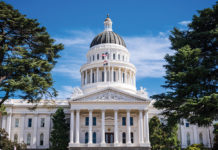Don’t look now, but the “when, where, how and who” of future
elections is all shifting as if it was being hit by an electoral
earthquake. Which it is.
Across California, the voter-approved Citizens Redistricting
Commission has redrawn every Congressional, State Senate and State
Assembly district, sometimes with drastic changes. At the same
time, a Sonoma County panel has proposed changes to the boundaries
of the five supervisorial districts.
Not only are the voting maps changing, but California’s Primary
Election is being moved back to June, after a few failed years of
holding the primary in February.
And, in the biggest of these seismic shifts, the next statewide
elections will be conducted under the new “open primary” rules
approved by voters in 2010 as Proposition 14.
If you were confused about your voter pamphlet before, just wait
until you try to figure out your “open primary” options. In that
format, the top two vote getters, regardless of party affiliation,
will advance to a run-off in the General Election. That means most
run-offs in northern California will be between two Democrats. That
kind of dynamic promises some big changes in who decides to run and
how they will shape their platforms and campaigns.
Before you start complaining, just remember, we all asked for
these kinds of election reforms and now we’re going to get it.
As background, every 10 years, following the U.S. Census count,
the nation’s 435 Congressional District boundaries must be redrawn
to equalize the number of voters in each district. State and other
districts must be redrawn at the same time to meet the “one man,
one vote” standard.
In past years, the incumbent elected officials were in charge of
realigning their own districts. The urge to draft new boundaries to
safely protect their own chance of relection was rarely avoided.
Hence, the new voter-approved citizen’s commission.
Newly proposed maps will make a radical change to Lynn Woolsey’s
and Mike Thompson’s congressional districts. Sonoma County would be
newly divided, with Santa Rosa, Rohnert Park and Cotati joined with
Napa, Lake and Solano counties in a new District 5. The remainder
of Sonoma County would be part of a new District 2 that would also
include Marin, Mendocino, Humboldt and Del Norte counties.
What all this means, with Woolsey’s retirement next year, is
almost all Sonoma County voters will get a new Congressman in
2012.
The new maps for the State Assembly and State Senate are equally
confusing, with the current assembly districts of Wes Chesbro and
Michael Allen being proposed to merge into a single district. At
the moment, neither man is too pleased with this idea. Stay
tuned.
At the county level, a modest growth in population is forcing
adjustments to the boundaries of the five supervisorial districts.
An appointed commission led by Sheriff Steve Freitas, County
Recorder Janice Atkinson and District Attorney Jill Ravitch has
proposed three mapping options.
The most favored plan would divide about 6,000 Santa Rosa voters
into new adjacent districts, leaving Mike McGuire’s north county
(4th) and Efren Carrillo’s west county (5th) districts with only
minor changes. However, the other two options still being
considered would make “drastic” and “radical” changes to these two,
semi-rural districts as some observers have complained.
A hearing on the proposed changes will be held next Tuesday,
Aug. 9 in Santa Rosa, with two more public meetings to be required
before a final decision is made in November.
All this shaking, rattling and rolling of election districts and
rules is being called “experimental democracy” by some observers.
Like imposed “term limits” these voter reforms could easily be
filled with many invisible and unintended consequences.
And you thought it wasn’t safe to walk into a voting booth
before. Now, you’ll need a Google Map just to cast a ballot.
— Rollie Atkinson
49.7
F
Healdsburg
April 19, 2025







